In this article, You will read Soil Classification, and Distribution of Soils in the World for UPSC (Biogeography).
Soil Classification
It is very difficult to achieve a classification of soils that is both meaningful to the geographer and at the same time an accurate reflection of all soil types and gradations. Two main types of classification used today may be recognized as those based on the assumed origins of the soil; and those based on the observable properties of the profile. Examples of each are given below.
Zonal System
One of the most popular classifications of soils has been the zonal system. This was proposed many years ago by Russian pedologists (Dukuchaiev, Glinka) who recognized the strong relationship between climate, vegetation, and soil zones throughout the world. Three main classes of soil are recognized.
- Zonal soils are those that are well developed and reflect the influence of climate as the major soil-forming factor.
- Intrazonal types are well-developed soils formed where some local factor is dominant.
- Azonal soils are those that are immature or poorly developed.
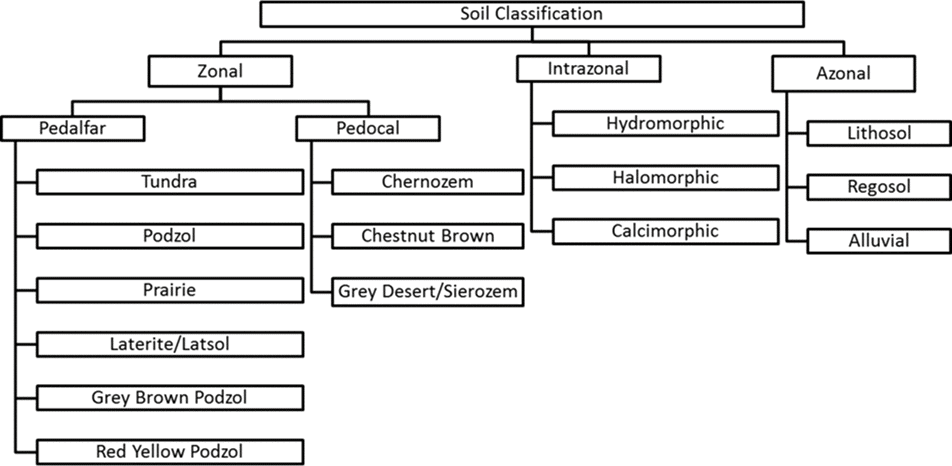
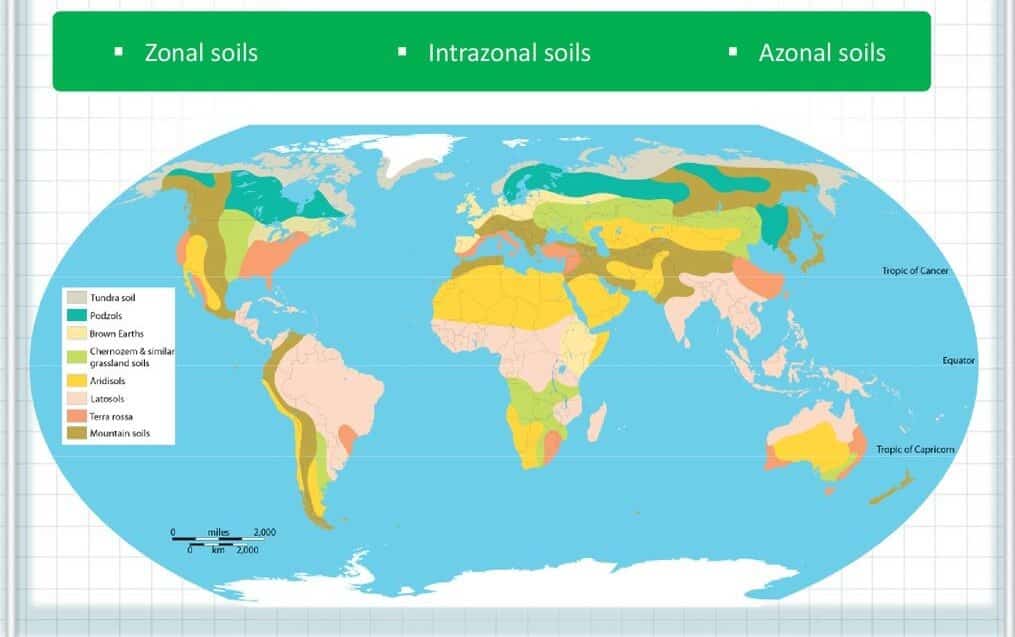
1. Zonal Types
These soils occur in broad geographical areas or zones. They are influenced more by the climate and vegetation of the area rather than the rock-type. They are mature, as a result of stable conditions over a long period of time.
Podzols (ash-soil):
The effect of the cheluviation process is to produce soils with a characteristic bleached E horizon. In some profiles, the humus is washed down the profile and accumulates as a humus-enriched B horizon, forming a humus podzol. In others, there is a marked concentration of iron oxide at this level, forming an iron podzol. Sometimes this takes the form of an iron-pan, impeding drainage, and resulting in a gley podzol. Podzols of these three types are most widespread in the cool climates immediately south of the tundra region and are found typically in association with coniferous forest.
Brown Earth:
These soils are found equator ward of the main podzol zone in milder climates supporting a deciduous forest cover. The soils still exhibit leaching, but of a far less intense nature than podzols. Although free calcium is absent from the upper part of the profile, there is no downward movement of sesquioxides, and their dispersed distribution gives rise to the overall brown colour of the soil. In addition, humus is well distributed throughout the profile and is less acidic than in podzols. Brown earths are widespread in Britain, except in the highland areas.
Tundra Soils:
The great variations that exist in the patterns of ground ice in the tundra cause equally complex variations in soils. Where slope conditions are fairly stable, the slow rate of plant decomposition usually results in the presence of a peaty layer at the soil surface. In areas of active slope movement, soils are inevitably thin. In the most extreme conditions where there is no plant growth, the soils are humic. The brown polar desert soils of the Antarctic are of this nature. By way of contrast, the birch-forested tundra margins in the northern hemisphere possess Arctic brown forest soils, characterized by a thick dark organic A horizon.
Sierozems:
Sierozems of desertic and semi-desertic areas can be regarded as extreme forms of chestnut soils in which lime and gypsum come even nearer to the surface because of upward capillary attraction. Since most of the plants are adapted to arid conditions, there is little leaf fall, and organic matter in these soils is low. However, when irrigated, Sierozems can be very fertile, because of their high base status.
Chernozem Soils:
The best examples of chernozems and their variants are found in association with steppe or prairie vegetation. The light rainfall of these areas leads to incomplete leaching and the formation of a calcium-rich horizon deep in the profile. Above this is a deep dark layer of soil which can be up to a meter thick. The humus content of this layer is surprisingly often no more than ten percent, the dark colour being associated with the base( alkaline )-rich mineral matrix. Chernozems have a well-developed crumb structure. The ideal parent material for this soil seems to be loess, which is widespread in the mid-west of North America, Russia and northern China.
Chestnut soils:
Chestnut soils occur on the arid side of the Chernozem belt under natural vegetation of low grass-steppe. The illuvial carbonate layer is closer to the surface than in chernozems and they have a lower organic content.
Prairie soils:
Prairie soils occupy the transition zone of increasing wetness between chernozems and forest brown earth
Grumusols:
These are dark clayey soils of savanna or grass-covered areas that have a warm climate with wet and dry seasons. There are no eluvial or illuvial horizons, but the whole solum is rich in bases, especially calcium, and hence its dark colour. These soils are characterized by a high degree of dry-season cracking.
Ferralsols:
Soils of intertropical areas are often referred to as lateritic, but strictly speaking, laterite is a weathering product and not a soil type. Most tropical soils are, however, rich in ferric oxide and are collectively known as Ferralsols. The abundance of sesquioxides of iron and aluminium accounts for the red, brown or occasionally yellow colour of the soil. The A horizon makes up the first meter of a typical profile and is usually acidic with low humus content. The B horizon commonly extends to fifteen meters or more and is predominantly clayey. Ferralsolic soils are low in fertility because of the lack of humus and bases.
2. Intrazonal Types
These soils occur within other zonal soils. It is a well-developed soil reflecting the influence of some local factor of relief, parent material, or age rather than of climate and vegetation.
Hydromorphic soils
Hydromorphic soils are those which have undergone gleying and are associated with marshes, swamps or poorly drained upland. Two main types can be recognized, according to the position of the water-table in the profile: groundwater gleys, where ground water is below the surface; and surface-water gleys.
Gleying is essentially the process of waterlogging and reduction in soils. In waterlogged soils where water replaces air in pores, oxygen is quickly used up by microbes feeding on soil organic matter.
Calcimorphic soils
Calcimorphic soils develop on calcareous parent material. Rendzinas are dark, organic rich, and are associated with chalk rock in Britain. Another Calcimorphic soil is terra rossa, which by contrast is a predominantly mineral soil and is found mainly in the Mediterranean region. The upper horizons are rich in clay and reddish in colour, sharply contrasting with the parent material.
Halomorphic (saline) soils
Halomorphic (saline) soils are mostly found in deserts. There are three common types in this group.
- Solanchak (white alkali soils) develop in depressions and exhibit white salt crusts in dry periods.
- Solonetz (black alkali soils) are the product of intense alkalinisation and are characterised by the presence of sodium carbonate.
- Solodic soils develop when leaching in the presence of excess sodium causes the loss of clays and sesquioxides, forming a bleached, eluviated horizon looking rather like a podzol.
3. Azonal Soils
It is that soil that has been developed by the process of deposition by the agents of erosion. It means that it has been made by the fine rocky particles transported from the far-off regions. These are immature soils and lack well-developed soil profiles. This may be due to the non-availability of sufficient time for them to develop fully or due to the location on very steep slopes which prohibits profile development.
Immature soils may exist because of the characteristics of the parent material or the nature of the terrain, or simply the lack of time for development. Such situations typically occur in areas where fresh parent material is being deposited or exposed.
- For example, on active flood-plains, alluvial soils have little or no profile development, because of their frequent burial under new sediments;
- Regosols are composed of dry and loose dune sands or loess.
- Lithosols are accumulations of imperfectly weathered rock fragments on steep slopes where erosion rates remove soil almost as fast as it is formed.
A number of criticisms have been leveled against the zonal concept.
- One is that the zonal soil type of one climate may well be found in another. For example, podzols, normally recognized as the zonal soil type of cool continental climates, also occur in maritime areas and in the tropics.
- Another difficulty concerns the azonal class: Azonal soils are not necessarily a reflection of the lack of time for development, but maybe a result of local factors that have arrested soil development over a long period.
- A third point is that soil profiles do not always reflect the prevailing climate, and may have characteristics inherited from previous climates.
USDA Soil Taxonomy
In recent years, the US Department of Agriculture has adopted a system of soil classification based on observed soil properties rather than genetic considerations.
There are twelve (12) orders of soils, which are distinguished largely on the basis of properties that reflect a major course of development, with considerable emphasis on the presence or absence of notable diagnostic horizons.
- Alfisols – “al” for aluminum, “f” for iron (chemical symbol Fe), two prominent elements in these soils
- Andisols – Rock formed from a type of magma in Andes Mountains volcanoes; soils high in volcanic ash
- Aridisols – Dry soils
- Entisols – These are recently formed soils
- Gelisols – Soils in areas of permafrost
- Histosols – These soils contain mostly organic matter
- Inceptisols – Young soils at the beginning of their “life”
- Mollisols – Soft soils
- Oxisols – Soils with large amounts of oxygen-containing compounds
- Spodosols – Ashy soils
- Ultisols – Soils that have had the last of their nutrient bases leached out
- Vertisols – Soils in which material from O and A horizons fall through surface cracks and end up below deeper horizons.
For this analysis, we will group the soil orders based on four factors that can characterize a particular order: maturity, climate, parent material, and high organic matter.
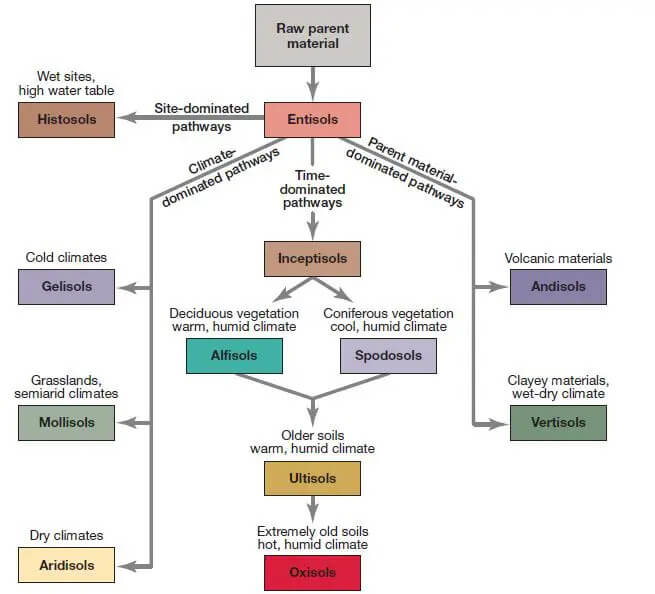
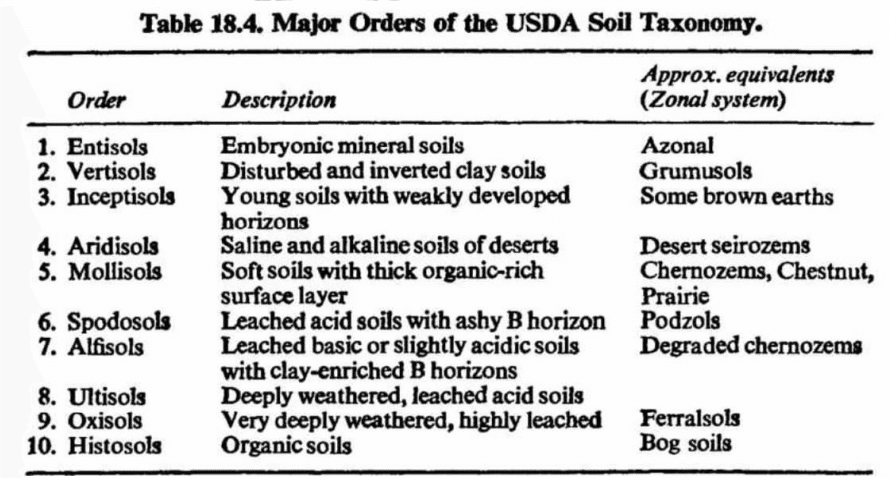


Soils Characterized By Maturity:
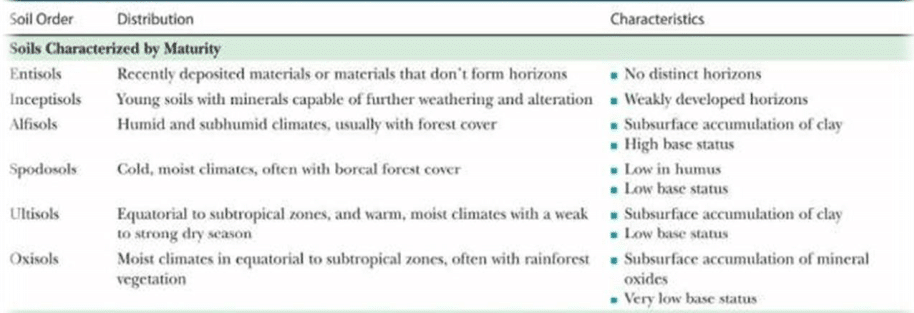
Where materials have been recently deposited soils have no horizons or poorly developed horizons and are capable of further mineral alteration.
Entisols and Inceptisols:
- Entisols are mineral soils without distinct horizons. They are soils in the sense that they support plants, and they may be found in any climate and under any vegetation. Entisols lack horizons, often because they are only recently deposited. They may occur in any climate or region.
- Inceptisols are soils with weakly developed horizons, usually because the soil is quite young. Inceptisols have only weakly developed horizons. Inceptisols of river floodplains and deltas are often very productive.
Entisols and Inceptisols can be found anywhere from equatorial to arctic latitude zones. Entisols and Inceptisols of floodplains and delta plains in warm and moist climates are among the most highly productive agricultural soils in the world because of their favorable texture, ample nutrient content, and large soil-water storage.
Alfisols and Spodosols:
- The Alfisols are soils characterized by a clay-rich horizon produced by illuviation and a high base status. The world distribution of Alfisols is extremely wide in latitude, ranging from as high as 60° N in North America and Eurasia to the equatorial zone in South America and Africa Because the Alfisols span an enormous range in climate types, four important suborders of Alf sols, each with its own climate affiliation
- Boralfs are Alfisols of cold (boreal) forest lands of North America and Eurasia. They have a gray surface horizon and brownish subsoil.
- Udalfs are brownish Alfisols of the mid latitude zone.
- Ustalfs are brownish to reddish Alfisols of the warmer climates.
- Xeralfs are Alfisols of the Mediterranean climate, with its cool moist winter and dry summer. The Xeralfs are typically brownish or reddish in color.
- Spodosols have a light-colored albic horizon of eluviation, and a dense spodic horizon of illuviation. They develop under cold needle leaf forests and are quite acidic. Spodosols are closely associated with regions recently covered by the great ice sheets of the Late Cenozoic Ice Age. Spodosols are naturally poor soils in terms of agricultural productivity. Because they are acidic, lime application is essential.
Oxisols and Ultisols:
- Oxisols have developed in the moist climates of the equatorial, tropical, and subtropical zones on land surfaces that have been stable over long periods of time. We find these soils over vast areas of South America and Africa in the wet equatorial climate, where the native vegetation is rainforest.
- Ultisols are similar to the Oxisols, but have a subsurface clay horizon. They originate in closely related environments. We find Ultisols throughout Southeast Asia and the East Indies. Other important areas are in eastern Australia, Central America, South America, and the southeastern United States. Ultisols are also vulnerable to devastating soil erosion, particularly on steep hill slopes.
Soils Characterized By Climate:

Mollisols:
Mollisols are soils of grasslands in sub-humid to semiarid climates. They have a thick, dark brown surface layer, termed a mollic epipedon. Because of their loose texture and high base status, they are highly productive. In North America, Mollisols dominate the Great Plains region, the Columbia Plateau, and the northern Great Basin. In South America, a large area of Mollisols covers the Pampa region of Argentina and Uruguay. In Eurasia, a great belt of Mollisols stretches from Romania eastward across the steppes of Russia, Siberia, and Mongolia.
Aridisols:
Aridisols are desert soils with weakly developed horizons. They often exhibit subsurface layers composed of an accumulation of calcium carbonate or soluble salts. With irrigation and proper management, they are quite fertile. The Aridisols are closely correlated with the arid subtypes of the dry tropical climate, dry subtropical climate, and dry mid-latitude climate.
Gelisols:
Gelisols are soils of permafrost regions that are churned by freeze/thaw ice action. They usually consist of very recent parent material, left behind by glacial activity during the Ice Age, along with organic matter that decays slowly at low temperatures.
Soils Characterized By Parent Materials

Vertisols:
Vertisols develop on certain types of volcanic rock in wet-dry climates under grassland and savanna vegetation. They expand and contract with wetting and drying, creating deep cracks in the soil. They are black in color and have a high content of the clay mineral montmorillonite, which is formed from the weathering of particular volcanic rocks. An important region of Vertisols is the Deccan Plateau of western India, where basalt, a dark variety of igneous rock, supplies the silicate minerals that are altered into the necessary clay minerals.
Andisols:
Andisols are unique soils that form on volcanic ash of relatively recent origin. They are dark in color and typically fertile. In moist climates they support a dense natural vegetation cover; they form over a wide range of latitudes and climates.
Soils High in Organic Matter

Histosols:
Histosols are organic soils, often termed peats or mucks. They are typically formed in cool or cold climates in areas of poor drainage. Throughout the northern regions of Spodosols are countless patches of Histosols. This unique soil order has a very high content of organic matter in a thick, dark upper layer.
General Classification of Soil
The most comprehensive basis for the classification of soils is the specific climate and vegetation under which the soil has grown and developed. Accordingly, the soils of the world can be broadly classified into two broad classes:
Pedalfurs
These soils have grown in humid areas under rich vegetation cover. These contain a greater proportion of aluminium and iron. But these lack in such important plant food as potassium, calcium, and phosphorus.
Pedocols
These soils which have grown under arid conditions. These retain all the elements which go to make plant foods. These soils are found in regions having less than 25 inches of rainfall per annum. Generally lighter in colour, they do not suffer from leaching and are alkaline. These broad classes of soil contain further subdivisions or sub-varieties on the basis of the type of vegetation cover, temperature conditions, and the amount of precipitation. Their sub-varieties will be clear from the chart given below:
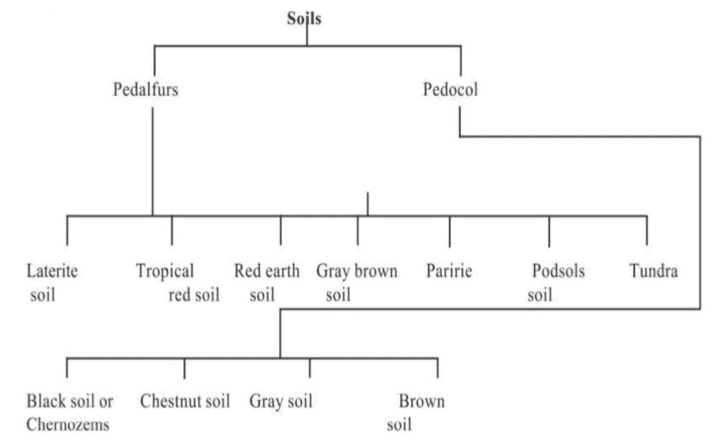

Distribution of soil is not given
You can refer this :
https://digitallylearn.com/global-distribution-of-soil-in-world-upsc-geography-optional-ias-pcs/
Excellent work
Can’t thank you enough!!!!!!!!!
If possible please add pics of soils.